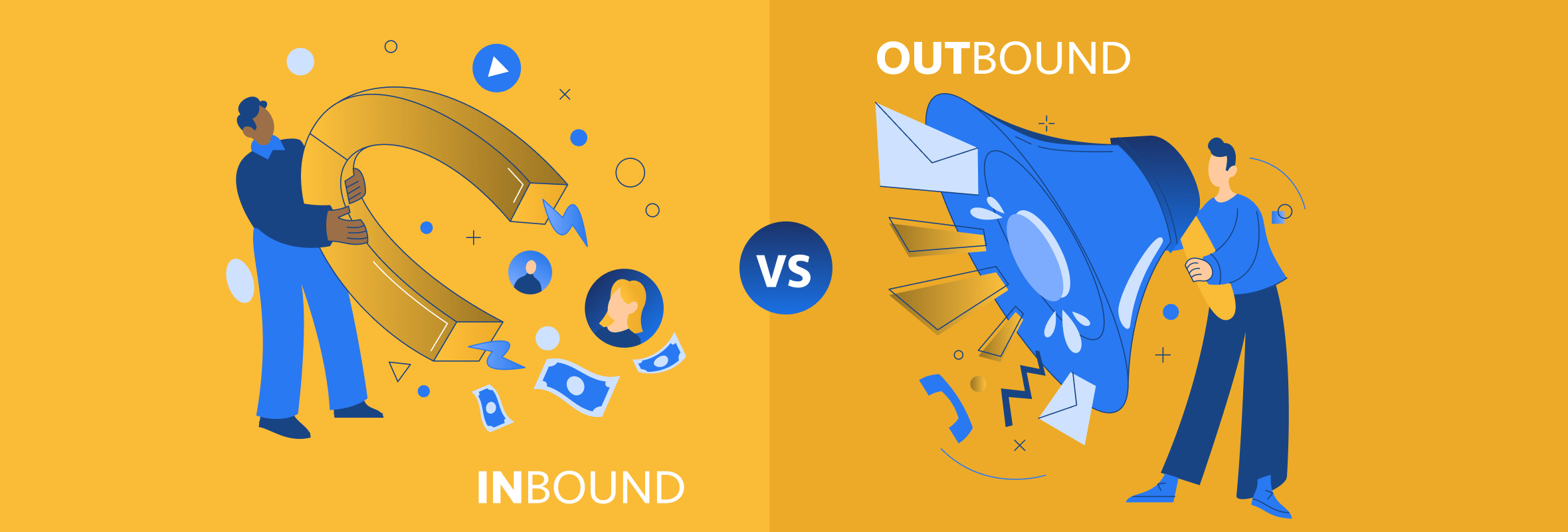Inbound vs Outbound Marketing: Using Both to Maximize Market Impact


Brent Walrath
This post was originally published in May 2019 and has been updated for accuracy and comprehensiveness.
Inbound vs outbound marketing: which is for you? The truth is that both play crucial roles in attracting, engaging, and converting customers for your business. However, the key to unlocking their full potential lies in understanding when and why to deploy each approach.
Begin by identifying your overall goals, as this is the critical first step in crafting a business strategy that manages risks, enhances team performance, and drives success. Once these goals are clear, you can refine your focus to specific marketing objectives.
| If your overall business goal is to… | Then your marketing goals should be… |
|---|---|
| Increase sales pipeline | Generate more marketing-qualified leads (MQLs) |
| Become top-of-mind in within your industry | Increase your brand awareness and impressions |
| Create a loyal customer/fan base | Increase engagement across social media |
With your marketing goals identified, you can determine whether an inbound or outbound strategy aligns best with your needs. For example, inbound marketing may focus on broader objectives like building brand awareness or generating organic leads. On the other hand, outbound marketing typically targets more immediate goals, such as driving sales quickly or increasing your audience on a timeline.
In this chapter, we will be focusing on how you can leverage both inbound and outbound marketing to achieve your business goals. We’ll specifically go over:
- What differentiates inbound vs outbound marketing
- The strengths and applications for each approach
- Popular inbound and outbound marketing strategies that drive conversions

B2B Marketing Strategy Framework: The Ultimate Guide to Business Branding
Get a more detailed view of the complete buyer’s journey with our downloadable guide.
What’s the difference between inbound and outbound marketing?
The difference between inbound and outbound marketing lies in how each approach identifies and engages potential customers to spark interest and convert them into leads or sales opportunities, a process known as prospecting.
What is inbound prospecting?
Inbound prospecting uses content and marketing strategies to attract and identify potential customers. Through tools like social media, SEO, and lead-driving content, it draws in people already interested in what you offer.
Inbound prospecting:
- Focuses on attracting leads through valuable content and experiences such as blogs, webinars, and social media.
- Drives traffic with organic methods such as search engine optimization (SEO), content marketing, social media, webinars, and influencer outreach.
- Engages customers by answering questions, solving problems, or providing insights they’re actively looking for.
- Nurtures brand engagement through personalized communication that provides value to the audience.
What is outbound prospecting?
Outbound prospecting actively seeks out potential customers through direct outreach, such as cold calls, emails, and targeted ads. It focuses on initiating contact with people who may not yet be aware of your product or service.
Outbound prospecting:
- Employs proactive outreach in which sales teams or marketers initiate contact with potential prospects — rather than waiting for potential prospects to come to you.
- Targets specific prospects based on criteria such as industry, job title, or company size, using a curated prospect list.
- Generates immediate interest by creating awareness, qualifying leads, and setting appointments or demos.
- Necessitates persistence and follow-up to nurture and re-engage prospects who might need more time, information, or encouragement to convert.

B2B Marketing Strategy Framework: The Ultimate Guide to Business Branding
Looking to create a strong B2B marketing strategy? This guide walks you through planning a data-driven marketing campaign.
Proven Inbound and Outbound Marketing Strategies That Work
Both inbound and outbound marketing provide unique strategies to attract, engage, and convert potential customers. Businesses can customize their approach to maximize impact depending on their goals, audience, and resources.
Inbound methods, like SEO and social media marketing, focus on building trust by delivering valuable content and creating engaging experiences. On the other hand, outbound strategies such as paid ads and cold calling aim for direct outreach, driving immediate interest and generating conversions. The following sections explore these approaches in more detail, highlighting the role of each tactic in the marketing mix.

Subscribe to EBQ's Bimonthly Newsletter

Subscribe to EBQ's Bimonthly Newsletter
Inbound Lead Generation Strategy: Meaningful Information that Attracts
An effective inbound lead generation strategy attracts customers by providing value and meeting the customer’s specific needs. Rather than reaching out directly, inbound marketing draws leads in by offering relevant solutions and building trust. Once this foundation is in place, you can boost your efforts with tools like SEO and social media marketing to reach more qualified leads.
Search Engine Optimization (SEO)
Search engine optimization (SEO) is the process of optimizing your website and its content to improve visibility on search engine results pages, which drives organic traffic and enhances user experience. SEO is a crucial strategy for enhancing your brand’s visibility and connecting with your audience. By optimizing your website and content for search engines, you can attract organic traffic and reach potential customers as they are searching for relevant solutions.
Here’s how SEO attracts the right audience:
- Improves Visibility: SEO improves your website’s ranking on search engine results pages, making it easier for them to find you when searching for relevant topics or solutions.
- Establishes Authority: High-quality, informative content establishes your brand as an industry authority, fostering trust with your audience.
- Provides an Enjoyable User Experience: A well-optimized website delivers a seamless user experience, keeping visitors engaged and encouraging return visits.
EBQ Tip: While we do not cover the full scope of our SEO optimization strategies here, we’ve written an article on How to Increase Domain Authority in 3 Steps.
Social Media Marketing
Social media marketing is the practice of using platforms like Facebook, Instagram, X, and LinkedIn to promote products, engage with audiences, and build brand awareness through targeted content and interactions. Social media is an effective platform for directly connecting with people. By engaging with users and sharing valuable content, you can cultivate a loyal community beyond simple brand recognition.
Here’s how social media fosters trust:
- Sharing Valuable Content: Posting helpful, informative content provides value to your audience, which positions your brand as a resource they can rely on.
- Building Relationships: Social media connects with your audience and humanizes your brand, making it easier for people to relate to and trust.
- Social Proof: Seeing others interact with your brand positively can help build credibility and influence potential customers’ buying decisions.
Outbound Lead Generation Strategy: Targeted Outreach that Converts
An effective outbound lead generation strategy targets potential customers proactively to drive immediate interest and conversions. By using direct methods like paid ads and cold calling through sales development representatives, your business can quickly engage high-value prospects, delivering faster results than organic reach. After the initial contact, follow-ups and nurturing tactics help drive conversions.
Paid Advertising
Paid advertising (also known as pay-per-click or PPC ads) boosts your brand’s visibility and reaches your target audience instantly by placing your ads in front of users who are actively searching for related products or services. Through platforms like Google Ads, you can target specific demographics, interests, and behaviors, ensuring your message is seen by the right people at the right time.
Here’s how paid advertising delivers results:
- Precise Targeting: Paid ads allow you to target specific demographics like age, location, interests, and behaviors to ensure your message reaches the right audience faster.
- Scalable Reach: Paid advertising provides flexibility to adjust budgets and bidding strategies, expanding or refining your reach based on business goals.
- Measurable ROI: Clear performance data from paid ads enables real-time campaign adjustments, ensuring optimal results and better ROI.
EBQ Tip: While we do not get into the specifics of our paid ads approach here, we did write an article on 5 B2B Google Ads strategies that convert. Read more to learn how to structure your ads.
Sales Development Representatives
SDRs, or Sales Development Representatives, are sales professionals who focus on the early stages of the sales process by identifying and qualifying leads before passing them to other team members for further engagement and closing. SDRs help with outbound lead generation by focusing on proactive outreach to drive immediate engagement and conversions. Cold calling is one of their primary tactics, allowing them to connect directly with high-value prospects.
Here’s how SDRs win over leads:
- Personalized Outreach: SDRs tailor their messaging to resonate with individual prospects, addressing specific pain points and offering relevant solutions.
- Consistent Follow-up: Through a well-planned sales cadence, SDRs maintain regular contact with leads, ensuring they stay top of mind and build rapport over time.
- Building Trust: By engaging prospects through meaningful conversations, SDRs establish credibility and trust, increasing the likelihood of conversion.

B2B Marketing Strategy Framework: The Ultimate Guide to Business Branding
Get a more detailed view of the complete buyer’s journey with our downloadable guide.
Inbound is Knowledge & Appeal, Outbound is Strategy & Pursuit
Inbound marketing offers knowledge and appeals to customers by providing universally valuable content that addresses their needs while building trust in your brand. In contrast, outbound marketing focuses on strategy and pursuit, customizing outreach to boost impressions within a set timeline and proactively reaching out to potential customers. Together they enable businesses to cast a wider net while nurturing relationships with high-quality leads.
Interested in creating a more dynamic marketing strategy that utilizes both inbound and outbound marketing tactics? EBQ’s Digital Marketing Solution Services will create a custom plan that leverages these strengths to optimize your marketing efforts for maximum impact and measurable results.
